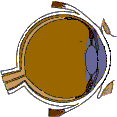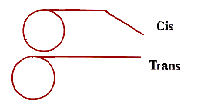Design in Nature Demands
a Designer, Let's Take a Look at the Chemistry of Sight
by Robert Harsh
 Light enters the eye through the cornea and the lens, which
then bends the light to focus on the retina. The lens and cornea have
no blood vessels but are nourished by aqueous humor that is contained
in a special chamber in the front of the eye. It is absolutely clear so as
to limit the refraction of light. Special ion pumps at the cellular level
keep cornea cells dehydrated when compared with other cells. This further
promotes clarity.
Light enters the eye through the cornea and the lens, which
then bends the light to focus on the retina. The lens and cornea have
no blood vessels but are nourished by aqueous humor that is contained
in a special chamber in the front of the eye. It is absolutely clear so as
to limit the refraction of light. Special ion pumps at the cellular level
keep cornea cells dehydrated when compared with other cells. This further
promotes clarity.
Your cornea is seven layered and the outside is very sensitive to pressure.
This, of course, allows the split-second blink to be accomplished that may
save the eye from being damaged. Your cornea is made of specially arranged
collagen fibrils that permit 99% of the light to pass through without scattering.
The iris and the pupil control the amount of light that goes to
the retina while the lens fine-tunes the focus.
Our lens is constructed by layering of very elongated cells that synthesize
and then become filled with the protein, crystallins. Eventually
synthesis stops, the cell dies and functions as a fiber that helps build
one of nature's most perfectly engineered structures. The lens is flexible
and is attached to ciliary muscles which change lens' shape.
Light travels through the near-perfectly-clear Vitreous Humor to
the retina. Vitreous humor is a special liquid that inflates the eyeball
and gives it the proper shape. It provides exactly the right pressure to
protect the retina. This fluid even gets filtered and recycled which prevents
loss of vision due to internal bleeding.
Light is captured by photoreceptor cells (rods and cones) of retina.
Each eye has 6.5 million light sensitive cones and 125 million rods, each
wired to the central NERCO's system and each sensitive to one photon. A computer
screen has 1/2 million light sensitive spots (pixels), each sending messages
to the computer.
The size of one photoreceptor cell is two microns. Now get this. The
optical resolution of the human eye is, you guessed it, two microns! Is that
a coincidence or what?!
The message of light is collected by the retina and is transformed
into a chemical message by neuroreceptors found in the retina. The choroid
is located behind the retina and is black to prevent reflected light from
blurring the image.
Let's explore the chemical sequence in the retina involved in reception
and transmission of the visual image. The following takes place within the
membrane-lined disks located inside the visual pigment cells know as rods
and cones;
1. Rhodopsin absorbs light. Rhodopsin consists of a protein
called Retinal and the membrane that surrounds it called Opsin.
2. The absorption of light causes the Retinal component to change its
shape from the cis-retinal form that has an angle in its shape to the trans-retinal,
which is a straight molecule.
3. This produces a change in shape of the Opsin component of the Rhodopsin.
So it is now called Metarhodopsin.
The following events involve the whole rod cell:
1. The shape change triggers the signal-transduction pathway. The altered
shape of Rhodopsin activates the G protein (of the signal-transduction pathway)
called Transducin. This G protein is located on the membrane of the
discs. Inactivated Transducin is bound to a small molecule known as GDP.
When Transducin is activated by the change in shape of Rhodopsin, the GDP
is chemically changed into GTP.
2. Activated Transducin in turn activates an enzyme known as Cyclic
GMP Phosphodiesterase. This enzyme digests c-GMP (Cyclic GMP), causing c-GMP
to become detached from Na+ channels which normally have c-GMP channels on
the rod's cell membrane. The Na+ channels normally have c-GMP attached to
them, and they allow Na+ and Ca+ to pass through them.
3. This makes the cell non-polarized. When c-GMPs are digested, they
detach and the Na+ channels close. The major consequence is that Ca+ ions
do not come in through the cell's membrane, resulting in an abundance of positive
ions outside the cell as compared to inside. The cell becomes hyper
polarized (really polarized, negative on the inside and positive on the
outside).
4. This hyper polarization causes the rod cells to stop releasing
Inhibitors Neurotransmitter in the synapse with other neurons. The stopping
of the release of inhibitory neurotransmitter is the message to the rest of
the nervous system that light has stimulated that particular rod cell
.
In order to use a photoreceptor cell again, the transretinal must be converted
back to cis-retinal. This is done by the Retinal Pigment Epithelium
(RPE). Cones and rods must be in physical contact with RPF. RPF digests
and replaces photoreceptor cell membrane. RPE collects used retinal and uses
Vitamin A to convert trans-retinal back to cis-retinal.
Each of these chemicals is a protein and is coded for by our DNA.
Does it really make sense that pure chance events caused
the DNA for these chemicals to come together in just the right sequences by
pure chance?
That conclusion
is irrational!
 Photoreceptors and the RPE require a huge amount of energy. The per gram
of tissue energy expenditure is:
Photoreceptors and the RPE require a huge amount of energy. The per gram
of tissue energy expenditure is:
--50% greater than kidney
--300% greater than cerebral cortex
--600% greater than cardiac muscle
What does a tissue that has a high metabolic rate need?
Abundant Oxygen and Glucose
How does large amounts of anything get to a cell?
Approximately 80% of blood supply to the eye travels through very large
choriocapillaries. Be comparison, only 5% flows through the retinal artery
that supplies the retinal layer in front of the photoreceptors. Choriocapillaries
literally bathe the photoreceptors in blood.
The famous evolutionist, Richard Dawkins, in his book The Blind Watchmaker,
ridicules the engineering of the retina. He laughed at the very idea of
placing the neurons in front of the photoreceptor cells. "The principle of
the thing would offend any tidy-minded engineer. (Dawkins, 1986)."
Dawkins was dead wrong again!
If the neurons were located behind the photoreceptors and the choriocapillaries
were in front, they would absorb all of the light! Blood readily absorbs
light.
The optic nerves from each eye travel to both left and right sides of
the brain. The brain interprets the various messages sent to it by: form/color/motion/depth
To suppose that the eye with all its inimitable contrivances for adjusting
the focus to different distances, for admitting different amounts of light,
and for the correction of spherical and chromatic aberrations, could have
been formed by natural selection, seems, I freely confess, absurd in the highest
degree.
Who made this valid observation?
Charles Darwin!
The wisest man who ever lived, Solomon, agreed with Darwin when he wrote:
"Ears that hear and eyes that see the Lord made them both (
Proverbs 20:12
)."
Back to Contents
Does God Exist?, JanFeb02.
 Light enters the eye through the cornea and the lens, which
then bends the light to focus on the retina. The lens and cornea have
no blood vessels but are nourished by aqueous humor that is contained
in a special chamber in the front of the eye. It is absolutely clear so as
to limit the refraction of light. Special ion pumps at the cellular level
keep cornea cells dehydrated when compared with other cells. This further
promotes clarity.
Light enters the eye through the cornea and the lens, which
then bends the light to focus on the retina. The lens and cornea have
no blood vessels but are nourished by aqueous humor that is contained
in a special chamber in the front of the eye. It is absolutely clear so as
to limit the refraction of light. Special ion pumps at the cellular level
keep cornea cells dehydrated when compared with other cells. This further
promotes clarity.
 Photoreceptors and the RPE require a huge amount of energy. The per gram
of tissue energy expenditure is:
Photoreceptors and the RPE require a huge amount of energy. The per gram
of tissue energy expenditure is: